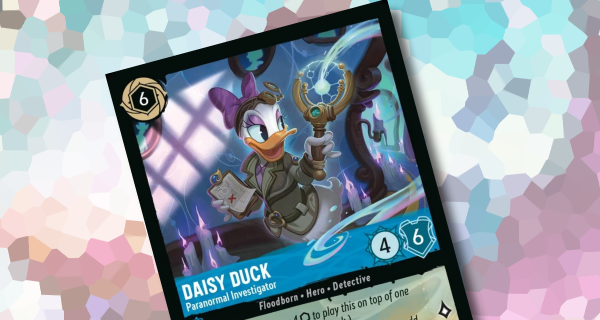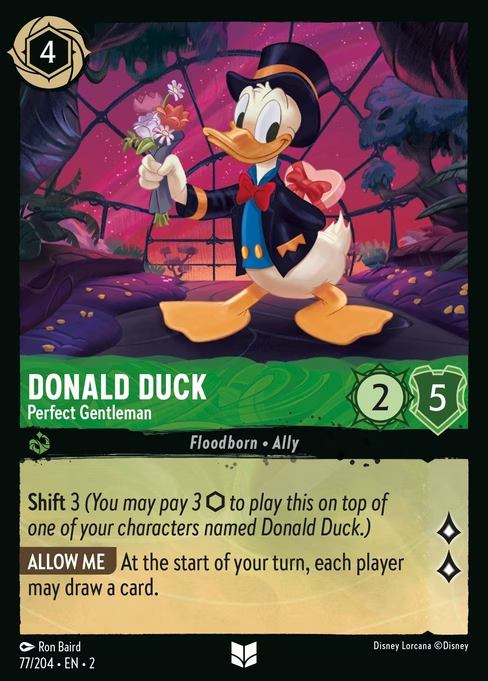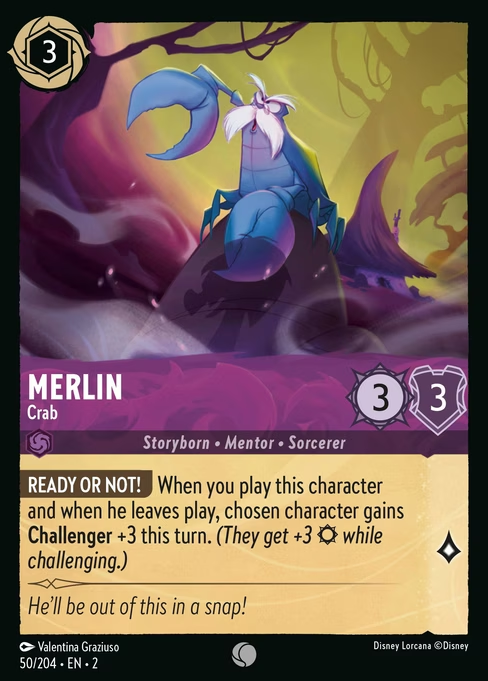TL;DR
Hiram Flaversham – Toymaker and Fortisphere were vital cards in the Sapphire-Steel decks of Disney Lorcana, serving as the backbone of the item combo engine. Their ban disrupts key ramp and control strategies. Now, Sapphire decks must pivot toward character-based ramp and midrange control while Steel decks must lean on alternative removal and tempo tools. Meanwhile, other archetypes—like Amethyst-Ruby, Emerald-Amethyst, and Ruby-Steel—stand to gain traction in the evolving meta.
The Role of the Banned Cards
If we are being honest, we could see this coming, this is healthy to keep Lorcana fun and exciting for everyone. For players who invested heavily in the Sapphire-Steel strategy, this ruling marks a major pivot point. Let’s take a closer look at what these cards brought to the table and how the meta might shift in their absence.
Hiram Flaversham – Toymaker
Hiram Flaversham was more than just a card; he was an engine of consistency. With his ability to dig through the deck and bring an item into your hand, he was the linchpin for building item-centric strategies. Players could reliably search for key items that not only accelerated ramp but also enhanced the overall synergy of their decks. The removal of Hiram means that Sapphire decks lose a critical way to generate card advantage and ensure a steady flow of resources.
Fortisphere
Fortisphere, on the other hand, was the powerhouse that allowed players to ready all their items at once during each turn. This meant that tapped items—ones normally bound by a cooldown period—could be reactivated, paving the way for repeatable value and combo loops. With Fortisphere gone, the ability to reliably generate infinite or sustained effects through item interactions is severely compromised, destabilizing the fundamental mechanics of Sapphire-Steel decks.
Rethinking Deck Strategies: Alternatives for Sapphire and Steel
With these two key cards now off-limits, players will need to adopt new strategies and explore alternative card options. Here’s how the Sapphire and Steel schools of thought can adjust:
New Directions for Sapphire Decks
The Sapphire side of the equation loses a significant part of its item engine and must pivot towards other strengths:
Card Advantage and Draw Alternatives:
Cards like Belle – Strange but Special provide essential draw power and can help maintain resource flow.
Gramma Tala – Spirit of the Ocean can fill some of the gap by offering card draw and recursion.
Character-Based Ramp:
Decks may now lean more heavily on character-based ramp options (think Tamatoa – So Shiny!) to accelerate plays and control the board without relying on a heavy item strategy.
Hybrid Strategies:
Consider blending with Amethyst to incorporate additional draw and control abilities or even integrate a touch of Ruby for more aggressive board control.
New Strategies for Steel Decks
Steel also centered around item synergy now must retool its approach:
Alternative Removal and Tempo Tools:
Cards such as Grab Your Sword and Hans – Scheming Prince provide solid removal and tempo, compensating for the lost synergy of item recycling.
Leaning on other aggressive pieces like Beast – Relentless can maintain the deck’s overall board presence.
Aggro-Control Hybrids:
Shifting towards Steel’s natural control options might involve mixing in cards from Ruby or Amethyst to balance aggression with board control, moving away from a heavy reliance on items.
Which Decks may be next to rise?
With the meta disrupted by the absence of Hiram Flaversham and Fortisphere, the playing field is wide open for other archetypes to rise. Here are some combinations that could now dominate the meta:
Amethyst-Ruby (Aggro-Control)
A blend of aggression and control, Amethyst-Ruby decks are poised to benefit from the void left by Sapphire’s diminished item engine. These decks offer speed, resilient board presence, and effective removal, positioning themselves as serious contenders.
Emerald-Amethyst (Hand Disruption and Tempo)
The slow, grinding nature of Emerald-Amethyst decks, featuring hand disruption and tempo manipulation, could capitalize on the slower build-up of non-item-based Sapphire decks. The synergy here can turn early control into significant long-term advantages.
Ruby-Steel (Aggro Midrange)
Ruby-Steel decks mix aggressive midrange strategies with the natural defensive and tempo tools Steel offers. By focusing on damage-based removal and efficient board control, these decks can provide a competitive edge without relying on item synergy.
Amber-Sapphire (Non-Item Ramp)
Lastly, even Sapphire still has room to operate in the meta. Decks that combine Amber’s ramp capabilities with a modified Sapphire approach—leveraging more creature-based or song-based ramp instead of traditional items—can still find success.
In conclusion
The banning of Hiram Flaversham – Toymaker and Fortisphere sends a clear message: the meta in Disney Lorcana is evolving. These cards were once the heart of item-based Sapphire-Steel decks. Their absence forces both Sapphire and Steel players to rethink strategies, turning to alternative ramp, control, and hybrid decks. Meanwhile, other archetypes like Amethyst-Ruby, Emerald-Amethyst, and Ruby-Steel are emerging as strong new contenders.
As the meta continues to shift, all eyes will be on how these new strategies perform in competitive play. Whether you’re a veteran player or new to the game, the next few tournaments will be fascinating battlegrounds for innovation and adaptation. Stay tuned for more insights, deck lists, and tournament analyses as the Disney Lorcana meta develops!
•




